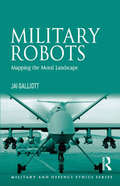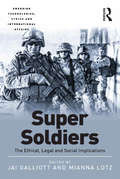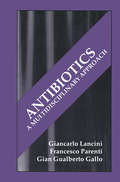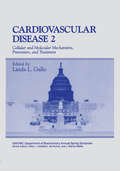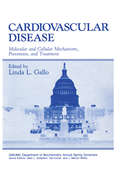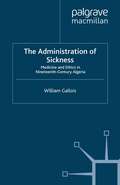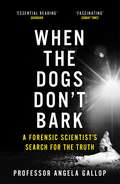- Table View
- List View
Mineral Processing and the Environment (NATO Science Partnership Subseries: 2 #43)
by Dr G. P. Gallios Prof. K. A. MatisMineral processing technologies have been used for decades to protect the environment and many examples of such applications are given here. The book covers four major subject areas: fundamentals; environmental pollution and its prevention; separation processes; and innovative techniques. Audience: Scientists, engineers and technologists conducting both applied and basic research into the different environmental aspects of mineral processing.
Military Robots: Mapping the Moral Landscape (Military and Defence Ethics)
by Jai GalliottPhilosophers have wrestled over the morality and ethics of war for nearly as long as human beings have been waging it. The death and destruction that unmanned warfare entails magnifies the moral and ethical challenges we face in conventional warfare and everyday society. Intrinsically linked are questions and perennial problems concerning what justifies the initial resort to war, who may be legitimately targeted in warfare, who should be permitted to serve the military, the collateral effects of military weaponry and the methods of determining and dealing with violations of the laws of war. This book provides a comprehensive and unifying analysis of the moral, political and social questions concerning the rise of drone warfare.
Military Robots: Mapping the Moral Landscape (Military and Defence Ethics)
by Jai GalliottPhilosophers have wrestled over the morality and ethics of war for nearly as long as human beings have been waging it. The death and destruction that unmanned warfare entails magnifies the moral and ethical challenges we face in conventional warfare and everyday society. Intrinsically linked are questions and perennial problems concerning what justifies the initial resort to war, who may be legitimately targeted in warfare, who should be permitted to serve the military, the collateral effects of military weaponry and the methods of determining and dealing with violations of the laws of war. This book provides a comprehensive and unifying analysis of the moral, political and social questions concerning the rise of drone warfare.
Super Soldiers: The Ethical, Legal and Social Implications (Emerging Technologies, Ethics and International Affairs)
by Jai Galliott Mianna LotzThe Spartan City State produced what is probably one of the most iconic and ruthless military forces in recorded history. They believed that military training and education began at birth. Post-World War II saw a shift to army tanks, fighter jets and missiles that would go on to fight the next huge battle in Northern Europe. Today, with the advent of unmanned systems, our hopes are attached to the idea that we can fight our battles with soldiers pressing buttons in distant command centres. However, soldiers must now be highly trained, super strong and have the intelligence and mental capacity to handle the highly complex and dynamic military operating environment. It is only now as we progress into the twenty-first century that we are getting closer to realising the Spartan ideal and creating a soldier that can endure more than ever before. This book provides the first comprehensive and unifying analysis of the moral, legal and social questions concerning military human enhancement, with a view toward developing guidance and policy that may influence real-world decision making.
Super Soldiers: The Ethical, Legal and Social Implications (Emerging Technologies, Ethics and International Affairs)
by Jai Galliott Mianna LotzThe Spartan City State produced what is probably one of the most iconic and ruthless military forces in recorded history. They believed that military training and education began at birth. Post-World War II saw a shift to army tanks, fighter jets and missiles that would go on to fight the next huge battle in Northern Europe. Today, with the advent of unmanned systems, our hopes are attached to the idea that we can fight our battles with soldiers pressing buttons in distant command centres. However, soldiers must now be highly trained, super strong and have the intelligence and mental capacity to handle the highly complex and dynamic military operating environment. It is only now as we progress into the twenty-first century that we are getting closer to realising the Spartan ideal and creating a soldier that can endure more than ever before. This book provides the first comprehensive and unifying analysis of the moral, legal and social questions concerning military human enhancement, with a view toward developing guidance and policy that may influence real-world decision making.
Green Alternatives and National Energy Strategy: The Facts behind the Headlines
by Philip G. GallmanIt is no secret that the United States’ dependence on oil—mostly foreign—puts the country in a precarious position. The United States needs innovative ways not only to power millions of automobiles on its highways but also to secure sustainable sources of fuel for the future. This book presents the latest facts and figures about alternative energy to any physicist, engineer, policymaker, or concerned citizen who needs a reliable source of information on the nation’s looming energy crisis. Philip G. Gallman focuses especially on green vehicles and the interrelationship between their design and various energy sources. He explains simply and clearly the complex energy and automotive engineering issues involved in developing green vehicles, measures their likely effect on energy resource demand, and considers what they might mean for national energy strategy. Addressing problems associated with renewable resources often overlooked or ignored in the popular press, Gallman explains what replacing oil with alternative sources of energy realistically entails. Can the nation satisfy its energy demands with wind turbines, solar power, hydroelectric power, or geothermal power? Is biodiesel or electricity the answer to our gas-guzzling ways? Organized logically and with an accessible narrative, Green Alternatives and National Energy Strategy guides readers through the essential questions and hurdles the United States must answer and overcome to transition from a petroleum-dependent nation to one that runs on sustainable, renewable energy.
Green Alternatives and National Energy Strategy: The Facts behind the Headlines
by Philip G. GallmanIt is no secret that the United States’ dependence on oil—mostly foreign—puts the country in a precarious position. The United States needs innovative ways not only to power millions of automobiles on its highways but also to secure sustainable sources of fuel for the future. This book presents the latest facts and figures about alternative energy to any physicist, engineer, policymaker, or concerned citizen who needs a reliable source of information on the nation’s looming energy crisis. Philip G. Gallman focuses especially on green vehicles and the interrelationship between their design and various energy sources. He explains simply and clearly the complex energy and automotive engineering issues involved in developing green vehicles, measures their likely effect on energy resource demand, and considers what they might mean for national energy strategy. Addressing problems associated with renewable resources often overlooked or ignored in the popular press, Gallman explains what replacing oil with alternative sources of energy realistically entails. Can the nation satisfy its energy demands with wind turbines, solar power, hydroelectric power, or geothermal power? Is biodiesel or electricity the answer to our gas-guzzling ways? Organized logically and with an accessible narrative, Green Alternatives and National Energy Strategy guides readers through the essential questions and hurdles the United States must answer and overcome to transition from a petroleum-dependent nation to one that runs on sustainable, renewable energy.
Antibiotics: A Multidisciplinary Approach
by G.G. Gallo G. Lancini F. ParentiIn this translation of the Italian second edition, the authors provide a comprehensive account of the current knowledge on antibiotics. They concisely describe how various scientific disciplines are involved in antibiotics research, development, and use. Their work also discusses the industrial and clinical development of new antibiotics, as well as the questions and controversies related to the function of antibiotics in nature. Antibiotics is richly illustrated with clear chemical structures, drawings, diagrams, and synoptical tables.
Cardiovascular Disease: Cellular and Molecular Mechanisms, Prevention, and Treatment (Gwumc Department of Biochemistry and Molecular Biology Annual Spring Symposia)
by Linda L. GalloThe Fourteenth Washington International Spring Symposium, held in Washington, D.C., in June 1994, brought together over 400 leading scientists from 21 countries to review and update research on cardiovascular disease. This group satisfied the symposium goals of formulating a more comprehensive and integrated picture of the events contributing to atherosclerosis and of exploring modified gene expression as an to understanding the causes of atherosclerosis and providing clues to the approach prevention and treatment. This volume contains most of the papers presented at the eight plenary sessions together with selected contributions from the special sessions. The multidisciplinary nature of the chapters and their authors should stimulate the interests of biochemists, cell and molecular biologists, pathologists, pharmacologists, epidemiologists, nutritionists, and clinicians. The volume is divided into eight sections which reflect the focus of the plenary sessions. Part I focuses on the pathophysiology of atherosclerotic plaques and predicts that the nature of the fibrous cap of atheroma determines plaque disruption and clinical events. Papers in Part II deal with atherogenic lipoproteins. The introductory paper reviews the current view of the role of plasma lipoproteins in atherosclerosis. With respect to the newer members on the list,: [oxidized LDL, Lp(a)] evidence is provided that suggests the involvement of one major gene in the development of oxidized LDL lipids. the expression of inflammatory genes, and the development of aortic fatty streaks.
Cardiovascular Disease: Molecular and Cellular Mechanisms, Prevention, and Treatment (Gwumc Department of Biochemistry and Molecular Biology Annual Spring Symposia)
by Linda L. GalloThe Sixth Annual International Spring Symposium on Health Sciences, held in Washington, D. C. , in May 1986, brought together over 650 scientists from 19 countries to review and update research on cardiovascular disease. In this volume, which contains 59 chapters, an internationally recognized group of authors con tribute up-to-date accounts of molecular and cellular processes occurring in the vessel wall in atherogenesis and describe approaches to the prevention and treatment of atherosclerosis. The volume is divided into six major sections. Two sections deal with current aspects of lipoprotein metabolism. In Part I, we are alerted to the impact on li poprotein metabolism of structural heterogeneity within the four broad lipoprotein classes. Attention then turns to the components that orchestrate lipoprotein metab olism. Apolipoprotein identities, processing, and functions are described, as are the roles of lipid transfer proteins in plasma lipoprotein remodeling. Hepatic lipase synthesis and secretion are described. In Part II, Nobel Laureates Michael S. Brown and Joseph L. Goldstein describe mutations in the LDL receptor that reveal the functions of its various domains and point out how understanding the LDL receptor has provided a rational basis for its regulation. A discussion of the role of receptors in regulating cholesterol uptake by tissues follows, with emphasis on receptor-ligand interactions. Additional pathways for cholesterol delivery to cells are explored, as are pathways for cholesterol egress.
Physics of Liquid Matter (Soft and Biological Matter)
by Paola Gallo Mauro RovereThis book offers a didactic and a self-contained treatment of the physics of liquid and flowing matter with a statistical mechanics approach. Experimental and theoretical methods that were developed to study fluids are now frequently applied to a number of more complex systems generically referred to as soft matter. As for simple liquids, also for complex fluids it is important to understand how their macroscopic behavior is determined by the interactions between the component units. Moreover, in recent years new and relevant insights have emerged from the study of anomalous phases and metastable states of matter. In addition to the traditional topics concerning fluids in normal conditions, the authors of this book discuss recent developments in the field of disordered systems in condensed and soft matter. In particular they emphasize computer simulation techniques that are used in the study of soft matter and the theories and study of slow glassy dynamics. For these reasons the book includes a specific chapter about metastability, supercooled liquids and glass transition.The book is written for graduate students and active researchers in the field.
New Tendencies in Mexican Art: The 1990's (New Directions in Latino American Cultures)
by R. GalloSince the 1980s there has been considerable interest in Mexico and its art, as one can see from the sheer number of exhibitions, catalogues, and articles devoted to the subject. Despite this interest, there are few books devoted to contemporary Mexican art. New Tendencies in Mexican Art is the first book-length study devoted to a generation of Mexican artists who have had enormous international success. It focuses on several 'tendencies' Gallo has identified as prominent themes in the work of these artists including orientalism, perversion, and a fascination with urban culture.
The Administration of Sickness: Medicine and Ethics in Nineteenth-Century Algeria
by W. GalloisThis book is the first comprehensive study of French medicine in nineteenth-century Algeria. It argues that the medicalization was a priority for colonial regimes, but this goal was thwarted by ineffectual French medicine, institutional rivalries, and the manner in which medicine became a focus for the resistance of French domination and rule.
SQUIDs, the Josephson Effects and Superconducting Electronics
by J.C GallopThe science of superconducting electronics was first developed over forty years ago, fifty years after the discovery of superconductivity. Since then, a wide range of applications has emerged, and more are envisaged within this ever expanding and exciting field. SQUIDs, the Josephson Effects and Superconducting Electronics chronicles this development from fundamental principles to the present work with high-temperature superconductors. The book discusses superconductivity, Josephson effects, and detectors of unparalleled sensitivity such as SQUIDs. It punctuates theory with practical discussions on how to harness this new science. This complete guide to the subject is an invaluable resource for graduate students and researchers with a specific interest in this field. It also provides guidance to those working in areas of industry where superconducting electronics could be applied.
SQUIDs, the Josephson Effects and Superconducting Electronics (Series In Measurement Science And Technology Ser.)
by J.C GallopThe science of superconducting electronics was first developed over forty years ago, fifty years after the discovery of superconductivity. Since then, a wide range of applications has emerged, and more are envisaged within this ever expanding and exciting field. SQUIDs, the Josephson Effects and Superconducting Electronics chronicles this development from fundamental principles to the present work with high-temperature superconductors. The book discusses superconductivity, Josephson effects, and detectors of unparalleled sensitivity such as SQUIDs. It punctuates theory with practical discussions on how to harness this new science. This complete guide to the subject is an invaluable resource for graduate students and researchers with a specific interest in this field. It also provides guidance to those working in areas of industry where superconducting electronics could be applied.
How to Solve a Crime: Stories from the Cutting Edge of Forensics
by Professor Angela GallopPre-order now: The gripping new book by the UK's most eminent forensic scientists, Angela Gallop__________CRIME [Noun]: An action or omission which constitutes an offence and is punishable by lawForensic science is one of the most important aspects of any criminal investigation.The impartial and objective evidence it provides can help convict the innocent and incarcerate the guilty. It enables courts to have the confidence in their decisions and to ensure that justice is done. Professor Angela Gallop has been at the forefront of forensics for more than 45 years. During her remarkable career, she has established and run forensic science laboratories and has worked on thousands of cases in the UK and across the world. In How to Solve a Crime, she describes some of her own and her colleagues most intriguing cases and the wide range of skills and techniques used to solve them. Whether it's looking at blood patterns and footwear marks at crime scenes to work out what happened, extracting data from suspects mobile phones to discover where they were at critical times, or analysing fragments of textiles fibers, glass or paint to determine where they might have come from, Gallop shows that every contact really does leave a trace and every trace can help to solve a crime. With unparalleled access and insight across a wide range of specialisms, How to Solve a Crime is a fascinating definitive and authoritative account of real-life forensic science. _________Praise for WHEN THE DOGS DON'T BARK'Fascinating' Guardian 'Offers a chilling glimpse into her life's work. . . fascinating stuff' Sunday Times 'Compelling' Daily Mirror 'A casebook that reads like The Encyclopaedia of Murder' Daily Express 'One of the professions leading lights' Woman & Home
When the Dogs Don't Bark: A Forensic Scientist’s Search for the Truth
by Professor Angela Gallop'Fascinating. A book that will be essential reading for every aspiring crime writer' Guardian'Offers a chilling glimpse into her life's work. Fascinating stuff.' Sunday Times 'Compelling' Daily Mirrror__________By the time I arrived at the wood yard in Huddersfield on a bitterly cold night in February 1978, the body of the 18-year-old victim had already been taken to the mortuary.__________Never before has criminal justice rested so heavily on scientific evidence. With ever-more sophisticated and powerful techniques at their disposal, forensic scientists have an unprecedented ability to help solve even the most complex cases. Angela Gallop has been a forensic scientist for over 40 years. After joining the Forensic Science Service, the first crime scene she attended was for a case involving the Yorkshire Ripper. As well as working on a wide range of cases in many countries around the world, she is now the most sought-after forensic scientist in the UK, where she has helped solve numerous high-profile cases, including the investigation that finally absolved the Cardiff Three the Pembrokeshire Coastal Path murders, and the killings of Stephen Lawrence, Damilola Taylor, Rachel Nickell and Roberto Calvi. From the crime scene to the courtroom, When the Dogs Don't Bark is the remarkable story of a life spent searching for the truth.'Fascinating' The Sun'a casebook that reads like The Encyclopedia Of Murder' Daily Express'One of the profession's leading lights' Woman & Home__________The compelling memoir from the UK's most eminent forensic scientist and some of the most fascinating criminal investigations she has worked on. You learnt about forensic pathology with Dr Richard Shepherd in Unnatural Causes and about anthropology with Professor Sue Black in All That Remains. Now it's time to learn about the scene of the crime. . .
The Emergence of the Acheulean in East Africa and Beyond: Contributions in Honor of Jean Chavaillon (Vertebrate Paleobiology and Paleoanthropology)
by Rosalia Gallotti Margherita MussiThis edited volume presents current archaeological research and data from the major early Acheulean sites in East Africa, and addresses three main areas of focus; 1) the tempo and mode of technological changes that led to the emergence of the Acheulean in East Africa; 2) new approaches to lithic collections, including lithic technology analyses; and 3) the debated coexistence of the Developed Oldowan and the early Acheulean. The chapters are the proceedings from the workshop titled “The Emergence of the Acheulean in East Africa”, held at University of Rome “La Sapienza” on September 12–13, 2013. The aim of the workshop was to bring together researchers currently working in this field in East Africa, in order to define the characteristics and the evolution of the early Acheulean. The volume was expanded with some chapters on the preceding Oldowan, on the African fauna and on paleovegetation, on the Acheulean in Asia and, eventually, on the Acheulean in Europe. The book is addressed to the scientific community, and will be of interest to researchers, graduate students, archaeologists, paleontologists, and paleoanthropologists. This volume is dedicated to the memory of Jean Chavaillon (March 25, 1925 - December 21, 2013), the leading archaeologist and Quaternary geologist who researched with unfailing enthusiasm the earliest human cultures and directed from 1965 to 1995 the French Archaeological Mission at Melka Kunture.
Process Intensification for Sustainable Energy Conversion
by Fausto Gallucci Martin van Sint AnnalandThis book addresses the application of process intensification to sustainable energy production, combining two very topical subject areas. Due to the increasing process of petroleum, sustainable energy production technologies must be developed, for example bioenergy, blue energy, chemical looping combustion, concepts for CO2 capture etc. Process intensification offers significant competitive advantages, because it provides more efficient processes, leading to outstanding cost reduction, increased productivity and more environment-friendly processes.
Process Intensification for Sustainable Energy Conversion
by Fausto Gallucci Martin van Sint AnnalandThis book addresses the application of process intensification to sustainable energy production, combining two very topical subject areas. Due to the increasing process of petroleum, sustainable energy production technologies must be developed, for example bioenergy, blue energy, chemical looping combustion, concepts for CO2 capture etc. Process intensification offers significant competitive advantages, because it provides more efficient processes, leading to outstanding cost reduction, increased productivity and more environment-friendly processes.
Radiographic Atlas of Skull and Brain Anatomy
by Massimo Gallucci Silvia Capoccia Alessia CatalucciThe English Edition contains a few differences from the first ItaHan Edition, which require an explanation. Firstly, some imag es, especially some 3D reconstructions, have been modified in order to make them clearer. Secondly, in agreement with the Publisher, we have disowned one of our statements in the preface to the Italian Edition. Namely, we have now added a brief introductory text for each section, by way of explanation to the anatomical and physiological notes. This should make it easier for the reader to understand and refer to this Atlas. These differences derive from our experience with the previous edition and are meant to be an improvement thereof Hopefully, there will be more editions to follow, so that we may further improve our work and keep ourselves busy on lone some evenings. Finally, the improvements in this edition are a reminder to the reader that one should never purchase the first edition of a work. UAquila, January 2006 The Authors Preface to the Italian Edition I have been meaning to publish an atlas of neuroradiologic cranio-encephaHc anatomy for at least the last decade. Normal anatomy has always been of great and charming interest to me. Over the years, while preparing lectures for my students, I have always enjoyed lingering on anatomical details that today are rendered with astonishing realism by routine diagnostic ima ging.
Stock Assessment: Quantitative Methods and Applications for Small Scale Fisheries
by Vincent F. Gallucci Saul B. Saila Daniel J. Gustafson Brian J. RothschildStock Assessment: Quantitative Methods and Applications for Small Scale Fisheries is a book about stock assessment as it is practiced. It focuses on applications for small scale or artisanal fisheries in developing countries, however it is not limited in applicability to tropical waters and should also be considered a resource for students of temperate fishery management problems. It incorporates a careful sample design, various mathematical models as a basis for predicting consequences for stock exploitation, and discusses the impact of exploitation on non-targeted species. This was a unique concept involving a collaborative effort between U.S. and host country scientists to address issues of regional and global concern through innovative research.Unlike other books on stock assessment that show mathematical models, this is the only book of its kind that discusses how an assessment is carried out. It looks at the field as a whole and includes sampling, age determination and acoustics.The book represents the culmination of a nine-year program financed by the United States Agency for International Development to provide new or improved methods of stock assessment for artisanal fisheries.
Stock Assessment: Quantitative Methods and Applications for Small Scale Fisheries
by Vincent F. Gallucci Saul B. Saila Daniel J. Gustafson Brian J. RothschildStock Assessment: Quantitative Methods and Applications for Small Scale Fisheries is a book about stock assessment as it is practiced. It focuses on applications for small scale or artisanal fisheries in developing countries, however it is not limited in applicability to tropical waters and should also be considered a resource for students of temperate fishery management problems. It incorporates a careful sample design, various mathematical models as a basis for predicting consequences for stock exploitation, and discusses the impact of exploitation on non-targeted species. This was a unique concept involving a collaborative effort between U.S. and host country scientists to address issues of regional and global concern through innovative research.Unlike other books on stock assessment that show mathematical models, this is the only book of its kind that discusses how an assessment is carried out. It looks at the field as a whole and includes sampling, age determination and acoustics.The book represents the culmination of a nine-year program financed by the United States Agency for International Development to provide new or improved methods of stock assessment for artisanal fisheries.

